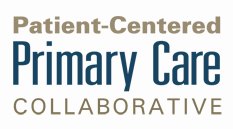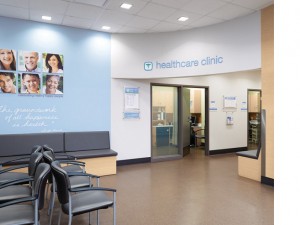This article contains an evidence-based report on US physician-led Patient Centred Primary Care (PCPC) “Homes” that are likely to be modeled and supported here in Australia.
i2P would  simply like to expand the debate for pharmacist-led models that will initially evolve from clinics that will be established in community pharmacies.
simply like to expand the debate for pharmacist-led models that will initially evolve from clinics that will be established in community pharmacies.
Many of these clinics will be staffed by nurses similar to the US model, which i2P has stated, leaves a pharmacist opportunity that could take up a lot of the slack involving unemployed pharmacists, and interesting work that could be supported by the skills of newly graduated pharmacists.
In the absence of a properly structured lead-organisation for clinical pharmacists, this emerging opportunity will become another wasted resource.
If that is allowed to happen it will be a tragedy for Australian pharmacy.
Community clinics attached to pharmacies in the US have become one of the good news stories of 2014. The growth in the number of clinic nurse practitioners has been spectacular, and has resulted because pharmacists have not been provided with tailored education and support to fill a role competitive with a nurse.
They have successfully transferred their “minor ailments” role to the nurses and have lost an opportunity to share the nurses “hands-on” role.
Thus we have simultaneously seen nurses gainfully employed through pharmacy developed clinics concurrent with pharmacist unemployment.
While i2P supports the concept of real collaboration between health practitioners we do not support the concept of pharmacist displacement, simply because pharmacy leadership bodies cannot rise above their competing interests and not embrace the profession as a whole.
Pharmacy schools should also view the opportunities created by providing appropriate training that can be accessed by working pharmacists in a suitably delivered format that meets their needs.
What follows is some supportive reports regarding pharmacy-based clinics in the US and some more details on the PCPC collaborative.
The clinic illustrated is one of t he newer versions developed by Walgreens in the US. It is encased within a large pharmacy.
he newer versions developed by Walgreens in the US. It is encased within a large pharmacy.
Currently, Walgreens has approximately 400 Healthcare Clinic locations throughout the nation.
A Walgreens study released last year found that retail clinics play an increasingly important role for health care delivery across the U.S., as patients are relying more frequently on nurse practitioners at retail clinics to provide chronic and preventive health services.
Specifically, the study found the percentage of visits to Healthcare Clinic locations for preventive services, screening and chronic visit utilization (combined) increased from 4% in 2007 to 17% in 2013. Furthermore, return patient visits to Healthcare Clinic climbed from 15% in 2007, to more than 50% in both 2012 and 2013.
These statistics have encouraged the development of a mobile phone app called the Healthcare Clinic Scheduler Application Program Interface, which gives software developers the opportunity to enable their mobile applications to allow customers to schedule an appointment at any Walgreens Healthcare Clinic across the United States.
This will link all clinics, enhance access to the service and accelerate its use.
Concurrently with the above development we see:
The number of nurse practitioners licensed in the United States has nearly doubled over the past 10 years, rising from approximately 106,000 in 2004 to 205,000 as of Dec. 31, 2014, according to data recently released by the American Association of Nurse Practitioners (AANP).
AANP also showed that more than 15,000 men and women graduated from nurse practitioner programs during the 2012-13 academic year.
The news closely follows the U.S. News and World Report ranking of nurse practitioners as the second best overall job of 2015, the 50th year of the nurse practitioner profession. It also follows research findings indicating that 66% of primary care physicians recommend careers as nurse practitioners.
“The explosive growth of the nurse practitioner profession is a public health boon considering our nation’s skyrocketing demand for high-quality, accessible care,” said AANP president Ken Miller. “The challenge now will be right-sizing state and federal laws such that all patients will have full and direct access to nurse practitioners, and these expert and dedicated clinicians will be able to provide care to the top of their education and clinical training.”
Nurse practitioners serve as primary and acute care providers across the country. They assess, order, perform and interpret diagnostic and laboratory tests; make diagnoses; initiate and manage treatment; prescribe medications and non-pharmacologic treatments; and counsel patients, their families and communities.
More than 50 years of peer-reviewed, independent research has shown nurse practitioners to be safe and cost-effective clinicians, with patient outcomes similar and sometimes better than those of physicians.
“All across the country, nurse practitioners are serving as a lifeline for patients, many who would otherwise struggle to access care,” said David Hebert, CEO of AANP. “It is our hope that these patients, as well as their families, employers and legislators, will join us in recognizing and honoring the national nurse practitioner community throughout this milestone 50th anniversary year.
 In the list of best health care jobs in the US in 2015, clinical nurse practitioners rank #2 after dentists, and pharmacists rank # 12 (after Estheticians and before Medical Equipment Repairers).
In the list of best health care jobs in the US in 2015, clinical nurse practitioners rank #2 after dentists, and pharmacists rank # 12 (after Estheticians and before Medical Equipment Repairers).
The most alarming news is that nurse practitioners are achieving this distinction on the back of community pharmacists because they do not seem to be able to mobilise and convert opportunities within their own environments and translate them to practice development and improvement, through appropriate training and education.
This type of US pharmacy clinic headed up by a nurse practitioner is also regarded as an alternative patient-centred home and has a physician component added through a Skype consultation, or in some of the busier clinics, actually employs doctors on staff.
Ownership of some of the larger clinics is attracting doctor involvement.
i2P simply wants to place on record that this is the situation that already exists in the US and that Australia is in a position to offer a pharmacist-led and owned clinical service that will be accepted by the general public.
We will miss this opportunity totally unless clinical pharmacists are given control of their own destiny, pharmacy schools (and others) tailor suitable on-the-job training programs and that the PGA looks to providing infrastructure and develop clinics under “shared risk agreements” in alliance with clinical pharmacists.
Pharmacies will get increased prescription traffic from these clinical pharmacists as well as attract prescriptions from the patients that attach themselves to the clinical service (having been former patients of other less progressive pharmacies).
And I don’t mean non-collaboration with nurses.
Nurses will make great alliance partners within these types of clinics and provide a more rounded service through the blending of the two cultures.
This aspect can be expanded further with the inclusion of other allied health providers as well.
Nor should it deter nurses establishing independent practices or in alliance partnerships with pharmacists or allied health practitioners outside of pharmacies.
The larger the variety the more competition for the best model, and this may be the lever to move the PGA into some sort of sensible action to save its “best and brightest” pharmacists.
Meanwhile, US doctors have been piloting their version of a patient “home” and have been making significant progress.
They have recently published a report on evidence-based results of which follows an executive summary excerpt:
Excerpt from Executive Summary
This year’s Patient-Centered Primary Care Collaborative (PCPCC) Annual Review of the Evidence summarizes new results from primary care patient-centered medical home (PCMH) initiatives published from September 2013 through November 2014 (since the publication of the previous Annual Review). Selected cost and utilization outcomes from a combination of peer-reviewed studies, state program evaluations, and industry publications are aggregated to present an overview of PCMH and primary care innovations happening across the country.
The evidence for the PCMH described here underscores the impressive and growing trends that tie the medical home model of care with reductions in health care costs and unnecessary utilization of services; improvements in population health and preventive services; increased access to primary care; and growing satisfaction among patients and clinicians. This is positive news for stakeholders of the PCMH and primary care and runs counter to one widely publicized study of an early PCMH pilot, which found no cost or utilization reductions (included and analyzed in this report). The call for increasing collaboration across the medical neighborhood and into communities where patients and consumers live and work is also growing, as described by our guest authors in Section 3 (page 29).
http://www.pcpcc.org/resource/patient-centered-medical-homes-impact-cost-and-quality#sthash.3rpZ1YPJ.dpuf
The patient-centered medical home (PCMH) is an effective way to reduce healthcare spending while raising quality indicators, says the Patient-Centered Primary Care Collaborative (PCPCC) in a new report. The organization’s annual review of evidence of the impact of the PCMH shows that the model can produce widespread cost cutting, improvements in service utilization, higher patient satisfaction scores, and better access to care for patients in a number of independent studies.
“The evaluations of the PCMH described in the report underscore the growing evidence base that ties the medical home model of care to reductions in health care costs and improvements in quality,” said Christopher Koller, president of the Milbank Memorial Fund in a press release. “However, in order for the PCMH to be sustainable, we need greater investment in primary care and less reliance on the fee-for-service payment system.”
Of the 28 industry reports, government studies, and peer-reviewed articles included in the overview, 17 found that patient-centered primary care helped to control spending, while 24 acknowledged the PCMH’s impact on better utilization of primary care, inpatient, and emergency room services. One hundred percent of peer-reviewed studies that reported on patient satisfaction noted that consumers were more satisfied with their care under the PCMH model, mirroring federal confidence that the team-based structure is worthy of significant financial investment.
In one peer-reviewed study published in Health Services Research in the summer of 2014, the PCMH model was responsible for a 4.9 percent reduction in total annual Medicare payment versus a control group, fewer ED visits, and a reduced rate of visits to surgical specialists. At New York-Presbyterian Regional Health Collaborative, patient-centered care produced a short-term return on investment (ROI) of 11 percent, while cutting ED visits and hospitalizations for chronic disease patients by nearly a third. When a chronically ill patient was admitted to the hospital, it was for an average stay that was 4.9 percent shorter than baseline.
The patient-centered medical home is also a crucial step for integrating care sites and providing a strong foundation for providers to take on financial risk as part of an accountable care organization (ACO), said Dr. Kavita Patel, Managing Director for Clinical Transformation and Delivery at Engelberg Center for Health Care Reform and a Fellow in Economic Studies at The Brookings Institution.
“ACOs offer another important opportunity for PCMHs to be meaningfully integrated into an advanced delivery model with a greater degree of financial and clinical risk for providers,” Patel writes in the report. “ACOs, to date, have largely been primary care centered with aligned financial incentives aimed at enhanced quality performance, improved care coordination and population health level interventions. PCMHs share these very tenets but often differ in the attribution and financial arrangements. The ACO model allows for primary care providers especially to transition to increased risk while still managing a plurality of patients that had been in fee-for-service models.”
As the healthcare industry accelerates its transition to value-based reimbursement and accountable care, the patient-centered medical home, now rooted in 44 states across the nation, is becoming an increasingly commonplace phenomena.
“Enhanced primary care in the form of the PCMH has the potential to change the quality and cost of health care in America,” said PCPCC CEO Marci Nielsen. “This report serves as a go-to resource to inform policymakers, providers, payers, and patients on the most recent evidence regarding the PCMH and its impact on the health care marketplace.”
It is the view of i2P that the doctor-led patient home in Australia will inevitably attract the lion’s share of government funding and will therefore proliferate at a faster rate than a pharmacist-led version.
While they will contain pharmacists there will be a battle to do the work to the full level a pharmacist licence permits.
It will contain limited “hands on” work for pharmacists.
The pharmacist model version has also to sort out the politics and unnecessary log jams (imposed mainly by the PGA) before it can truly take off. The pharmacist model may not initially attract government funds (even though the PGA has put a request before government), but it will have more of a case as it proves successful.
As the PGA has not discussed its clinical plan with pharmacists generally, it may not be practical or acceptable.
There needs to be more than one type of patient home model to provide a degree of patient choice and competition.
Someday we may see pharmacist aspirations sorted out and silo mentalities disappear across all of health.
One can only live in hope.
However, the reality is that because the leadership organisation for clinical pharmacists is stifled we are about to see a great opportunity wasted because it is a PGA-led negotiation with no clinical pharmacist input.
Unless that log jam is cleared, pharmacists lose a “hands on patient” opportunity with pharmacist future jobs being displaced in favour of nurses, as the US model is gradually adopted by larger pharmacies.
Not a great future that the current generation of pharmacists will be passing on to future generations.
How selfish and short-sighted!
